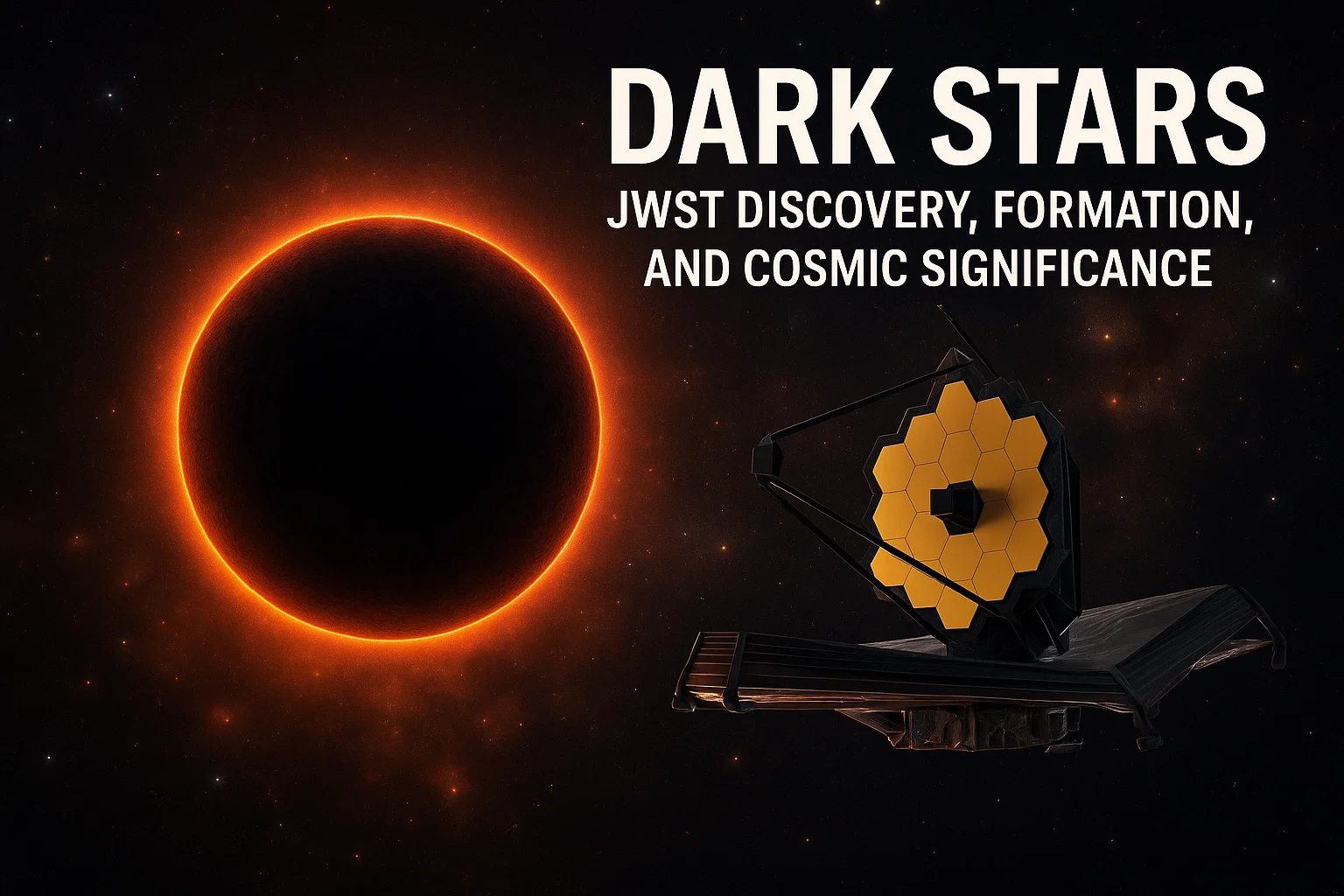Dark Stars – JWST Discovery, Formation, and Cosmic Significance
The James Webb Space Telescope may have detected the first-ever dark stars—ancient cosmic objects powered by dark matter annihilation. Learn how they differ from black holes and reshape our view of the early Universe.
Context
Recent observations from the James Webb Space Telescope (JWST) have revealed four extremely distant cosmic objects that may represent the first-ever detected supermassive dark stars. These findings could revolutionise our understanding of the early Universe, dark matter, and the origins of supermassive black holes.
What Are Dark Stars?
Dark stars are hypothetical celestial objects theorised to have formed a few hundred million years after the Big Bang—long before normal stars began to shine. Unlike typical stars powered by nuclear fusion, dark stars would have been fuelled by the annihilation of dark matter particles.
These stars would primarily contain hydrogen and helium, the two most abundant elements in the early Universe. The key to their existence lies in Weakly Interacting Massive Particles (WIMPs), one of the most widely studied dark matter candidates. When WIMPs collide, they can annihilate each other, releasing energy. This energy could heat the surrounding gas, preventing gravitational collapse and sustaining the star without fusion.
As a result, dark stars could have grown to enormous sizes—potentially reaching millions of times the mass of our Sun and spanning billions of kilometres across. Their sheer scale and faint glow make them prime targets for infrared telescopes like JWST.

How Are Dark Stars Different from Black Holes?
| Feature | Dark Stars | Black Holes |
|---|---|---|
| Nature | Hypothetical early stars made of hydrogen, helium, and dark matter | Regions of spacetime where gravity is so intense that nothing, not even light, can escape |
| Energy Source | Powered by heat from dark matter annihilation (WIMPs) | No internal energy source; formed by the collapse of massive stars or dense matter |
| Visibility | Emit radiation, potentially observable in infrared and ultraviolet | Do not emit light directly; detected via accretion disks or gravitational waves |
| Structure | Puffy, gas-rich stellar objects with diffuse outer layers | Singularity surrounded by an event horizon; no physical surface |
| Formation Epoch | Among the first generation of stars (~300 million years post-Big Bang) | Formed later, possibly seeded by the collapse of dark stars |
| Astrophysical Role | May act as precursors to supermassive black holes in quasars | Drive galactic evolution and emit strong gravitational waves |
Why Are They Important?
1. Clues to the Early Universe
If confirmed, dark stars would represent an entirely new phase of cosmic evolution. Their existence would push back the timeline of star formation and reveal that dark matter played a direct, energetic role in shaping the early Universe. This would offer a rare glimpse into an era when the first cosmic structures were forming.
2. Connection to Dark Matter Physics
Dark stars provide an observable link between particle physics and cosmology. Detecting them would indirectly confirm the presence and behaviour of WIMPs, offering evidence for the nature of dark matter—one of physics’ greatest mysteries.
3. Explaining Supermassive Black Holes
Astronomers have long struggled to explain how supermassive black holes—with billions of solar masses—appeared less than a billion years after the Big Bang. One theory suggests that dark stars could have collapsed directly into these black holes, bypassing the long process of stellar evolution.
4. Observable Signatures
Unlike black holes, dark stars would emit faint radiation detectable in infrared (IR) and ultraviolet (UV) wavelengths. The JWST, with its unparalleled infrared sensitivity, can detect these signatures at extreme distances—billions of light years away. The four observed objects exhibit properties consistent with theoretical dark star models: they are brighter, larger, and cooler than expected for early galaxies or typical stars.
The Role of the James Webb Space Telescope
The JWST has fundamentally changed how we observe the early Universe. With its ability to peer back over 13 billion years, it has detected objects that challenge existing models of galaxy and star formation.
If these four distant sources are indeed dark stars, JWST’s discovery could mark a turning point in astrophysics. Future spectroscopic analysis will determine whether the light emitted by these objects aligns with dark star predictions or if they are unusually bright primordial galaxies.
Regardless of the outcome, JWST’s findings demonstrate the telescope’s power to test theories of dark matter, cosmic evolution, and star formation on an unprecedented scale.
Conclusion
Dark stars, once purely theoretical, may soon move from speculation to observation. These colossal, ancient objects—powered not by fusion but by dark matter annihilation—could explain how the first supermassive black holes formed and how dark matter shaped the cosmos.
The James Webb Space Telescope has opened a new window into the early Universe, bringing scientists closer to answering some of astronomy’s most profound questions: What is dark matter? How did the first structures form? And what came before the first stars we know today?
If confirmed, the discovery of dark stars would reshape our understanding of cosmic history, linking the invisible realm of dark matter with the luminous Universe we can see.
Subscribe to our Youtube Channel for more Valuable Content – TheStudyias
Download the App to Subscribe to our Courses – Thestudyias
The Source’s Authority and Ownership of the Article is Claimed By THE STUDY IAS BY MANIKANT SINGH





